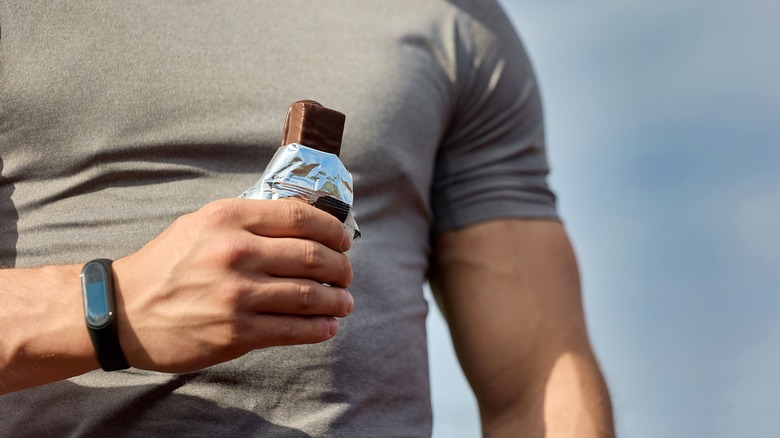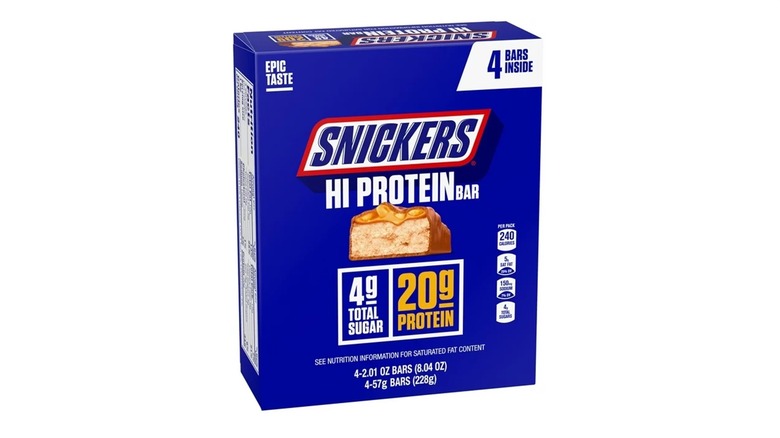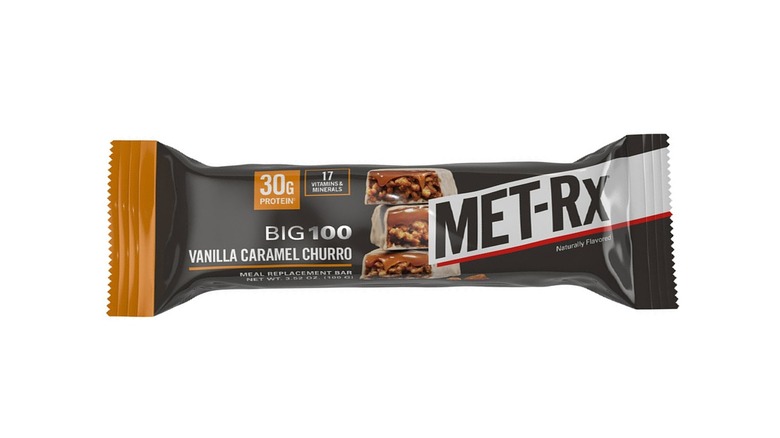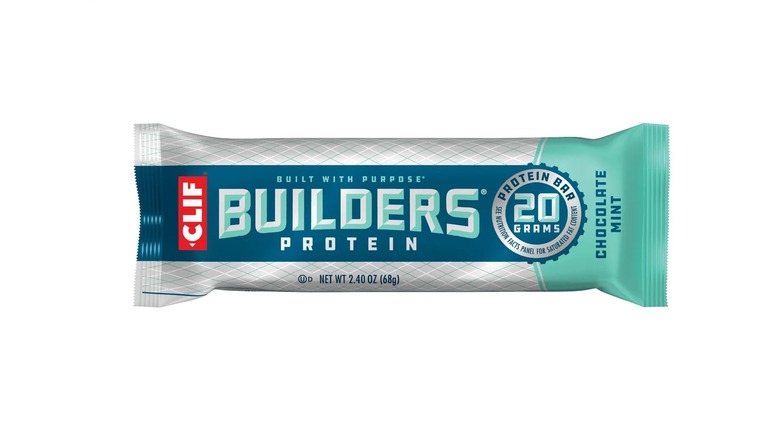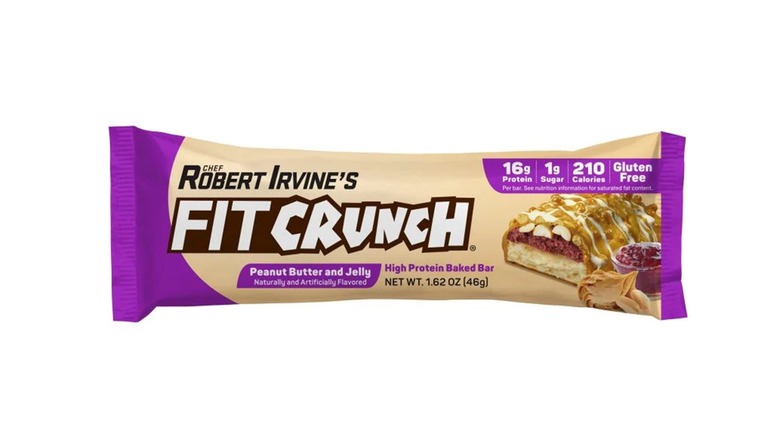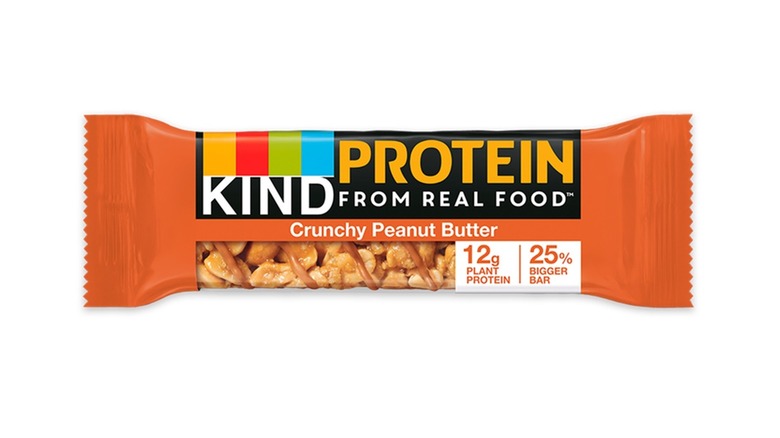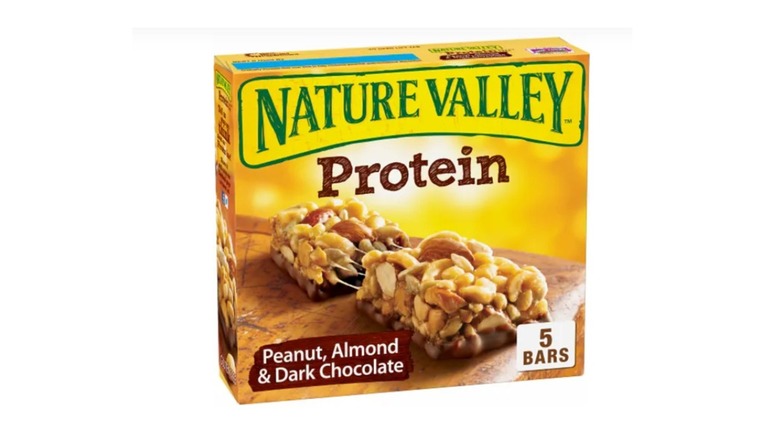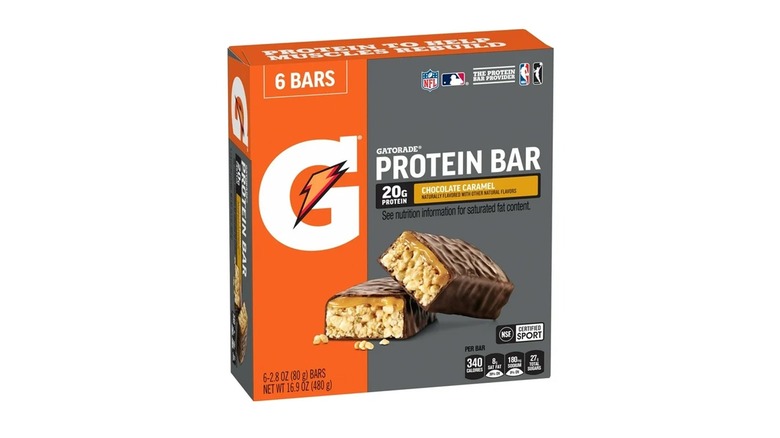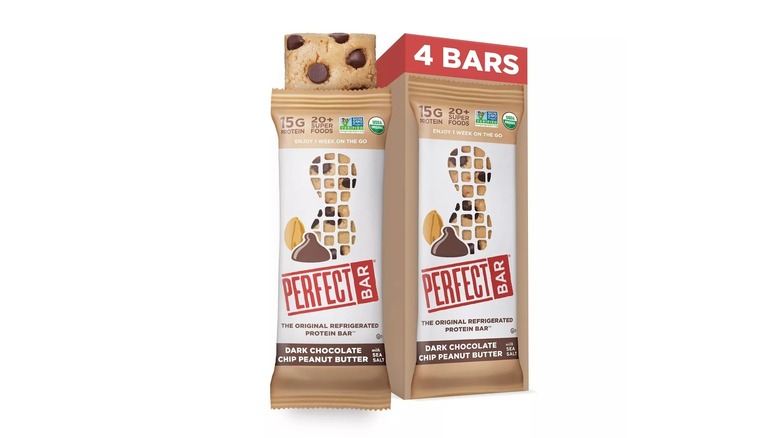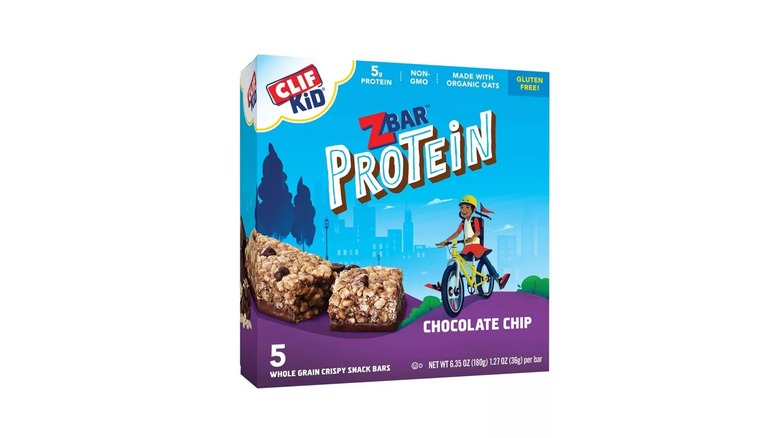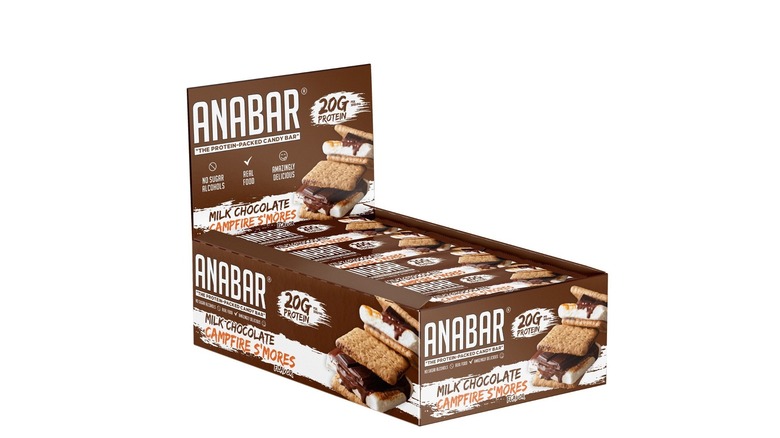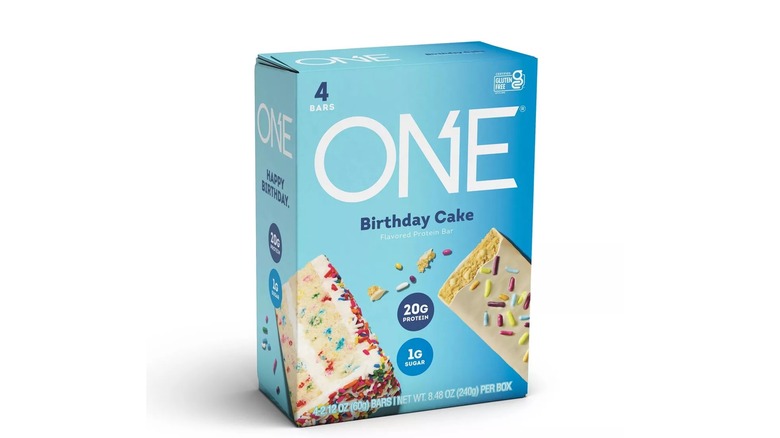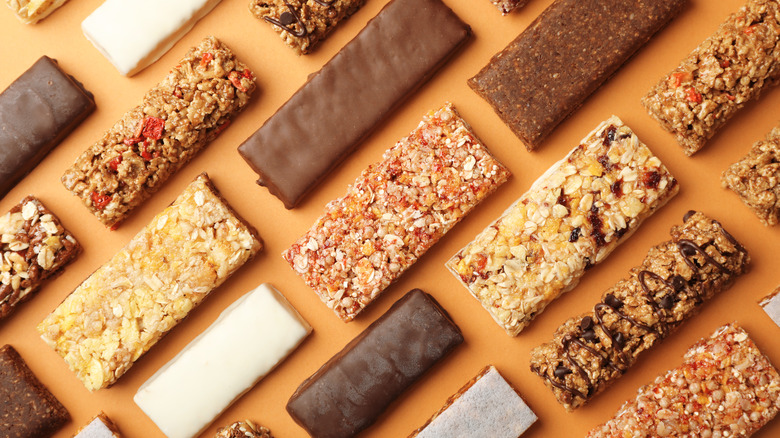11 Unhealthiest Protein Bars
The advent of the high-protein movement gave a turbo boost to the protein bar market. Old-school fitness folks may remember the days when only Power Bar and Tiger's Milk offered energizing meal-replacement options and protein-forward snacks for active humans in need of a nutritious boost. Now, good luck heading down the bar aisle at the grocery store or supplement shop without being overwhelmed by all the options lining the shelves. There's practically a bar for every taste to help you keep your macros in check while on the go, thanks to an industry capitalizing on fast fitness and even faster American lifestyles.
It seems unlikely that a health food concept like protein bars would have a darker underbelly — dark chocolate coating notwithstanding. But there is such a thing as an unhealthy protein bar, and their numbers are quite large, both in variety and in the concentration of less-nutritious ingredients utilized. These usually come in the form of highly processed, sugar-sweetened formulations that use saturated fat in fillings and coatings, reducing the overall nutritional value of the bar despite the high protein content. Most of these bars come at a premium price, which means you could easily be spending your hard-earned fitness money on products that aren't helping you hit your personal best. We did the heavy lifting to figure out which protein-packed bars are the unhealthiest and what makes them less than optimal, and we'll go into more detail about our selection process at the end.
Snickers Hi-Protein
Yep, it's Snickers, entering the protein bar circuit with a product the company proclaims as high protein, no less. It's right to be dubious about a candy bar dressed up in workout gear trying to pass itself off as a health food supplement. It's not such a wild leap to think that a factory cranking out bars of candy could easily shift to pumping out bars of protein. Tied into the overlap is the possibility that the candy and the protein merge into something less than desirable, which is what seems to have happened here.
A regular Snickers may keep you satisfied if you're nothing but hungry, but if you're looking for post-workout satisfaction, a Snickers Hi-Protein bar is destined to disappoint. The ingredients list includes gelatin, considered to be an incomplete form of protein due to a lack of the amino acid tryptophan. There's also palm oil in the peanut butter and carrageenan, a troublesome thickener that can cause digestive issues. And even with 20 grams of protein to 10 total grams of fat providing a 2:1 ratio, there are 5 grams of saturated fat included, which is a full 25% of the daily recommended amount. Leave the Snickers products for your cheat day and find a more beneficial protein bar for your nutritional snacking.
MET-Rx Big 100 Vanilla Caramel Churro
MET-Rx Big 100 Vanilla Caramel Churro isn't just named for a delicious dessert; it has the nutritional profile of one, too. The powerful 30 grams of blended protein called out on the front of the label is mighty seductive to a gym rat, but a deeper dive into the nutritional facts reveals a less thrilling profile. The super-high 380 calories derive in part from the 22 grams of sugar, 20 of which are added sugars. The label may say this is 40% of your daily value, but the American Heart Association says this is closer to a full day's worth of sugar. You'll also find 460 milligrams of sodium, which is great for electrolyte replenishment, provided you've used enough to need a top-up. If not, you're just chowing down on extra salt.
Clearly, this bar is for high-energy expenders like powerlifters, die-hard athletes, and cross-fitters who blow through an enormous number of calories with each workout. Unless you're one of them — and even if you are — skip this sugary supplement, leave the dessert-style bar in the dust, and find a more balanced protein source.
Clif Builder Bar Chocolate Mint
Lovers of all things chocolate and mint will have difficulty refusing Clif Builder Chocolate Mint protein bars ... but they should avoid them like the saturated fat-loaded snacks they are. Regardless of this bar being plant-based, gluten-free, and low-glycemic — three important nutritional designations — it's full of other ingredients your body is better off without. It includes common nutritional offenders like 6 grams of saturated fat, representing 29% of your recommended daily quantity, and 17 grams of cane sugar, which accounts for the entire sugar content and 33% of your desirable added sugar intake. It's proof positive that one bar can carry a lot of poor nutrition along with the good stuff.
With only 9 total grams of fat countering the impressive 20 grams of protein, it's easy to be swayed into thinking there's a balanced meal substitute to be enjoyed here. But healthy eating means more than just getting a hearty dose of protein in a supplemental item that doesn't taste gritty or artificially sweetened like so many others do. These particular Clif bars may offer a cool and refreshing alternative in the power bar kingdom, but it's not the healthiest vehicle for accommodating your protein needs.
FITCRUNCH Peanut Butter and Jelly
Anytime you can work a childhood favorite like a PB&J sandwich into your workout program, life gets better, even if it's only a protein bar that recreates the flavors in some fashion. But when that favorite is FITCRUNCH Peanut Butter and Jelly protein bars, the situation gets a little sticky — and not just from the peanut butter in the recipe. Bodybuilder and celebrity chef Robert Irvine provides the brains and the brawn behind FITCRUNCH, a gourmet take on what a protein bar can be. Gourmet is synonymous with luxury, though, and the nutrient info on a PB&J bar demonstrates how indulgent this supplement can be.
This is another super-high calorie bar, plunking down a brain-busting 400 calories with 13 grams of saturated fat, enough to soak up 65% of your daily allotment. In addition to the whey protein blend, the ingredients also include bovine gelatin, palm kernel oil, and maltitol, a plant-based sweetener that can cause a laxative effect in some people. Reading labels like this one clues you in on how highly processed protein bars can be. Even using beet and grape extracts as natural food dyes can't redeem the other unhealthy aspects of this bar.
KIND Crunchy Peanut Butter
On the surface, KIND Crunchy Peanut Butter sounds like a fantastic option for a protein-filled meal replacement bar. The verbiage on the label even crows about being "protein from real food," a claim most protein bars don't even pretend to pull off. Reading the ingredient selection is a breath of fresh air; it's one of the least processed bars on the market, containing ingredients that are all recognizable and edible. The one stand-out among elements like sea salt and peanut flour is palm kernel oil, a highly saturated fat that helps keep foods soft. Food scientists aren't entirely convinced this oil is a beneficial ingredient, which is disappointing in an otherwise favorable selection.
Where you'll find trouble is in the fat content. Any protein bar that contains more fat grams than protein grams isn't playing fair. In the case of KIND Crunch Peanut Butter, there are 18 grams of fat and 12 grams of protein. Four of those fat grams are the saturated type (hello, palm kernel oil), ringing up to 20% of your daily intake in one meal-replacement bar. With so much potential for a truly nutritious protein bar, KIND only kind of lives up to the possibilities.
Nature Valley Peanut Almond Dark Chocolate
Nature Valley may be a snack producer par excellence, but when it slaps extra protein in the formula and comes up with a bar like its Peanut Almond Dark Chocolate option, it comes precariously close to overlapping with the more dedicated protein bar section of the grocery store. Unsuspecting shoppers could easily be swayed by the call-out of 10 grams of protein in each bar stamped above a luscious-looking slab of seeds and nuts resting on a bed of chewy chocolate.
If you're looking for a snack that's more advisable than a handful of Oreos, you may find what you're looking for here. But if you're looking for actual nutrition, the 12 grams of fat (4 grams saturated, or 19% of your whole day's portion) versus the 10 grams of protein will throw you for a curve. The 5 grams of added sugar are sure to cause a little sticker shock, too, considering they come from corn syrup — yes, corn syrup, the kind used to make candy bars and soft drinks. That little disclosure should be enough to convince you that this is one unhealthy protein bar.
Gatorade Peanut Butter Chocolate
One of the world's best-known sports drinks companies grows leaps and bounds in the supplement sector with Gatorade Peanut Butter Chocolate protein bars. This sweet foray into new territory sounds like a perfect pair-up for a post-workout replenishment, a Gatorade bottle-and-bar combo that puts back the fluids and electrolytes you've lost while delivering doses of glucose and protein to recovering muscles in need of nourishment. If nothing else, the color of these bars is a much more natural shade than anything you can find in the brand's sports drink collection. That doesn't necessarily make them nutritious, however.
It may not be the 360 calories that will convince you this bar is unhealthy; that's about what you'd have if you ate an extra meal during the day, which is usually the purpose of a protein bar. And it may not be the 9 grams of saturated fat, though that equates to 47% of what you should be consuming in an entire day. Even the 20 grams of protein compared to the 13 total grams of fat could be in your comfort zone. But once you learn this bar has 24 grams of added sugar — 48% of your recommended allocation — you'll understand that better products abound elsewhere. Put your running shoes on and head for more mindful protein bars instead.
Perfect Bar Dark Chocolate Chip Peanut Butter
Nothing like a misnomer in a product title to lead you to believe it's better for you than it actually is. Such is the case with Perfect Bar Dark Chocolate Chip Peanut Butter protein bar. It proudly announces itself to be "the original refrigerated protein bar," thanks to the lack of shelf-stabilizing preservatives in the formula. That's a major win for active eaters looking to shed the legacy of strange chemicals and excessive processing in their diet. And reading the back of the package is like perusing a recipe for a super-green smoothie. How could this bar go so far off the mark with such a promising foundation?
Maybe it happened with the calories, a considerable 330 per bar, likely due to the high-fat content from the peanut butter. It could also be the 4 grams of saturated fat, which is 20% of the ideal daily dose. Or it could be the 12 grams of added sugar, which may come from the honey and chocolate, but still, it's added sugar, and 24% of what's advised to have each day, at that. And the 20 grams of fat poised against the 15 grams of protein won't help matters, either. Taken all together, this so-called perfect bar is a perfect one to omit from your gym bag.
Clif Kid ZBar Protein Chocolate Chip
Keeping your kids well-fed while on the run is a noble pursuit all parents undertake, and having a prepackaged protein bar at the ready would be a huge help in achieving that goal. If Clif Kid ZBAR Protein Chocolate Chip were a little more considerate of a child's nutritional needs, it might be the product to fill the gap. One glance at the ingredient list tells you that this unhealthy snack is little more than a cookie in protein bar clothing.
What Clif gets right with its Kid ZBAR are the 130 calories, 5 grams of protein, and 2.5 grams of fat content, all favorably balanced for a child's daily consumption. What Clif gets incredibly wrong in this bar is the number of sweeteners it uses to make the bar palatable to the younger snacking set. The first ingredient on the list is tapioca syrup, followed close behind by cane syrup and cane sugar, then chicory fiber syrup and tapioca syrup solids a bit lower. That's five different sweeteners, resulting in 8 grams and 17% of a child's daily added sugar allowance. If that doesn't send up a flurry of nutritional red flags with mindful parents, maybe the use of palm kernel oil will. As the shady side of protein bars goes, this is one bar that can't get much lower.
Anabar S'mores
Heavy lifters trying to keep up with their enormous protein needs may think they have a flavorful friend in Anabar S'mores protein bars. But this offering from GNC is a repackaging of too many undesirable ingredients wrapped around the protein as a way to make the medicine go down smoothly, if not healthfully. The company crows about not including sugar alcohols right on the package, which may draw the eye of anyone sensitive to these tricky sweeteners.
That may be the only thing Anabar has to be proud of with this bar, considering what actually is used to sweeten this nostalgia-flavored meal replacement bar. It's sugar ... so much sugar — in the peanut butter, plus molasses and honey, then a little more sugar in the milk chocolate coating. Also, there's brown rice syrup in the whey crisps, sugar and corn syrup in the marshmallow layer, and a pile-up of sugar, corn syrup, honey, and molasses in the graham crackers. Somewhere along the way, hydrogenated oils jump into the fray, but by then, anyone who reads the label concludes that this is one of the unhealthiest protein bars you can sink your teeth into.
ONE Birthday Cake
Another company that tries to persuade the health-minded to partake in its products by replicating beloved desserts, ONE offers a line of sweets-inspired protein bars that includes Birthday Cake, complete with sprinkles and white frosting. It's a clever presentation that ties into the notion that getting through your workout means you deserve a little treat. And since that little treat comes with 20 grams of protein and only 220 calories, it seems like a decadent way to stick to your high-protein plan without sacrificing your joy entirely.
Well, that birthday cake-like protein bar comes with 6 grams of saturated fat, 30% of what's advisable to eat in a day, let alone in one meal replacement bar. The more troubling part of the ingredients list comes from the lengths ONE goes to to make sure its supplement is sweet enough. Oligosaccharides, maltitol, polydextrose, and sucralose — four different types of artificial sweeteners — all make appearances in the formula's line-up. This is in addition to actual sugar, which shows up pretty far down the list but still contributes to the profile. Compared to giving in and downing this processed chemical bomb, finding a healthy source of protein should be — ahem — a piece of cake.
How we chose our bars
I've eaten many different types of protein bars over the years, weighing the benefits of having high quantities of protein available in a package deal that sometimes forgets it's supposed to be nutritious overall. I've discovered that although substantial protein content is the obvious draw in any protein bar, the amount considered "substantial" varies among bars, as well as consumers. Your ideal protein intake in bar or other form will depend on your nutritional needs, of course, which means the level of protein grams varies from person to person. High-quality protein trumps low-quality protein, obviously, so I checked into the types of protein in the bars on the list to see how they fared.
The drawbacks of the unhealthiest protein bars we found were the usual suspects that derail the best-laid nutritional plans of anyone looking for a relatively clean bar to supplement their meals. Anytime sugar, fat, saturated fat, sodium, or overly processed ingredients insert themselves into the equation, a bar takes a turn for the unhealthy. I identified the bars with the most troubling numbers where those elements were concerned, as well as choosing particularly high-calorie bars, as this can be nutritionally counterproductive even if the bar meets your macronutrient expectations.
